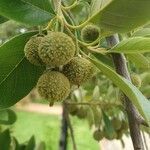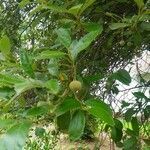Shrub or tree, up to 13 m. tall; bark pale to dark grey, smooth; branchlets ± densely stellately tomentellous.. Leaf-blades variable in form, size, texture and indument-density, ovate-oblong, elliptic, or lanceolate, apex subacute or obtuse, base cuneate to rounded, papery to firmly chartaceous or subcoriaceous, yellowish stellate-tomentellous to-tomentose, sometimes glabrescent with age, rarely practically glabrous from the beginning except the nerves, entire, undulate or shallowly serrate, 3.5–9(–14) cm. long, 2–5(–6) cm. broad; lateral nerves 6–9 pairs, rather prominent beneath, veins ± parallel to each other, slightly raised; petiole 0.5–1.5(–2) cm. long.. Flowers yellowish-greenish tomentellous, the ♂ in short 3–7-flowered axillary cyme-like racemes; peduncle ± 5 mm.; pedicels up to 7 mm.; basal bracts minute, caducous.. Sepals narrowly ovate, slightly keeled, 4–5 mm. long and 2 .5 mm. broad.. Petals broadly obovate, obtuse or subacute, ± 5 mm. long, the basal inner scale oblong, fleshy, 1 mm.. Filaments ± 1 mm.; anthers oblong, ± 2 mm.. Female flowers solitary in the upper axils; peduncle ± 5 mm.; pedicels up to 1.5 cm.. Sepals and petals similar, but slightly longer and narrower.. Ovary tomentellous and minutely tuberculate; styles glabrous, ± 3 mm. long.. Capsule globose, almost woody, ± 2 cm. in diameter, yellowish-greenish tomentellous or tomentose, softly warted.. Seeds subglobose, covered with a bright orange-red aril; testa smooth, dark.. Fig. 11.
Tree or shrub, up to 17 m high, unarmed, dioecious. Leaves alternate, petiolate, elliptic or ovoid, variously toothed, sometimes discolorous; hairy pockets in axils of main veins; stipules absent. Flowers unisexual. Male flowers in axillary cymes, on longish pedicels; stamens 8-10, free; filaments short, anthers 2-thecous. Female flowers solitary on long pedicels; sepals 5-parted, narrowly elliptic, valvate, deciduous, puberulous; petals 5, often very similar to sepals, elliptic, imbricate, puberulous; ovary sessile, ellipsoid; style short and thick, divided into 5 branches. Flowering time Aug.-Dec. Fruit globose, woody, several-seeded capsule; valves 2-5, pubescent, sometimes tuberculate.
Leaf-lamina 3.5–9 x 2–5 cm., ovate-oblong, elliptic or lanceolate, apex acute or sometimes rounded, base broadly cuneate or rounded, margin entire, slightly undulate or shallowly and distantly toothed, finely yellowish-stellate-tomentellous above when young, later glabrescent, densely yellowish-stellate-tomentellous below although some forms are eventually glabrescent on both sides; nerves in c. 9 pairs, rather prominent below, veins slightly raised, ± parallel between the nerves; petiole up to 1–4 cm. long, tomentellous.
Shrub or tree, up to 17 m high, unarmed, dioecious. Bark pale grey, smooth. Leaves petiolate; blade glabrous or white or rusty stellate, with hairy pockets in axils of veins below. Flowers: male flowers in axillary cymes on long pedicels, female flowers solitary on long pedicels; sepals 5-parted; petals 5, often very similar to sepals, elliptic, each with a fleshy gland at base, yellowish green; Sep.-Dec., Apr.-Jun. Fruit globose, woody, rough; seeds bright orange-red.
Dioecious, semi-deciduous tree, up to 17 m tall, with smooth grey bark. Leaves elliptic, usually toothed, with hairy pockets in lower vein axils, male flowers in axillary cymes, female flowers solitary in axils, yellowish. Fruit round, pale inside with red seeds.
Dioecious, semideciduous tree with smooth grey bark to 17 m. Leaves elliptic, usually toothed, with hairy pockets in lower vein axils, male flowers in axillary cymes, female flowers solitary in axils, yellowish. Fruits round, pale inside with red seeds.
Male flowers yellowish-green, in short 3–7-flowered axillary cymes; peduncle c. 5 mm. long, tomentellous; pedicels similar, 2–7 mm. long with minute, caducous, tomentellous bracts at the base.
Bush or tree up to 13 m. tall, probably evergreen; bark pale grey, smooth; young branches yellowish-brown, stellately tomentellous, the youngest parts often with tufted ferruginous hairs also.
Ovary ovoid or obovoid, densely puberulous and minutely tuberculate; styles 5, c. 3 mm. long, glabrous or very sparsely puberulous, divergent, free for c. 2 mm., connate below.
Petals 2 mm. long, broadly obovate, slightly keeled, obtuse or subacute at the apex, densely puberulous on both sides, basal scale subfleshy, oblong.
Sepals c. 5 x 2.5 mm. narrowly ovate, slightly keeled, subacute at the apex, densely yellowish-puberulous on both sides, free almost to the base.
Fruit 2 cm. in diam., a hard, woody, globose capsule, splitting from the apex into 5 valves, yellowish-green, densely tomentellous, waited.
Female flowers solitary in the upper axils; peduncles c. 5 mm. long; pedicels up to 1.5 cm. long with 1–2 minute bracts at the base.
Stamens c. 10; filaments up to 1 mm. long; anthers oblong, 2.2 x 1.3 mm., stellately puberulous.
Petals c. 8 x 3.5 mm., narrowly oblong, subacute at the apex, otherwise as in the male.
Sepals narrower as a rule than in male flowers, c. 7 x 2.5–3 mm., narrowly oblong.
Seeds c. 10, 7 mm. in diam., bright orange-red, viscid, subglobose; testa smooth.




